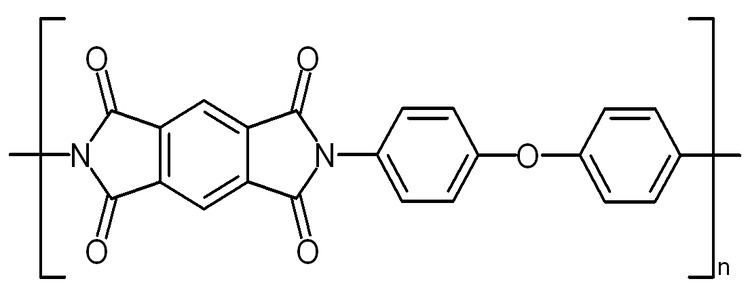 | ||
Vespel is the trademark of a range of durable high-performance polyimide-based plastics manufactured by DuPont. The one shown in the structure on the right was the first to be commercialized.
Contents
Characteristics and applications
This high performance polymer is mostly used in aerospace, semiconductor and transportation technology. It combines heat resistance, lubricity, dimensional stability, chemical resistance, and creep resistance, to be used in hostile and extreme environmental conditions.
Unlike most plastics, it does not produce significant outgassing even at high temperatures, which makes it useful for lightweight heat shields and crucible support. It also performs well in vacuum applications, down to extremely low cryogenic temperatures. However, Vespel tends to absorb a small amount of water, resulting in longer pump time while placed in a vacuum.
Although there are polymers surpassing polyimide in all of these properties, the combination of them is the main advantage of Vespel.
Thermophysical properties
Vespel is commonly used as a thermal conductivity reference material for testing thermal insulators, because of high reproducibility and consistency of its thermophysical properties. For example, it can withstand repeated heating up to 300 °C without altering its thermal and mechanical properties. Extensive tables of measured thermal diffusivity, specific heat capacity, and derived density, all as functions of temperature, have been published.
Magnetic properties
Vespel is used in high-resolution probes for NMR spectroscopy because its volume magnetic susceptibility (−9.02 ± 0.25×10−6 for Vespel SP-1 at 21.8 °C) is close to that of water at room temperature (−9.03×10−6 at 20 °C Negative values indicate that both substances are diamagnetic. Matching volume magnetic susceptibilities of materials surrounding NMR sample to that of the solvent can reduce susceptibility broadening of magnetic resonance lines.
Processing for manufacturing applications
Vespel can be processed by direct forming (DF) and isostatic molding (basic shapes – plates, rods and tubes). For prototype quantities, basic shapes are typically used for cost efficiency since tooling is quite expensive for DF parts. For large scale CNC production, DF parts are often used to reduce per part costs, at the expense of material properties which are inferior to those of isostatically produced basic shapes.
Types
For different applications, special formulations are blended / compounded. These shapes are produced by three standard processes: 1) Compression Molding (for plates and rings) 2) Isostatic Molded (for Rods) 3) Direct-Forming (for small size parts produced in large volumes) Keep in mind that direct formed parts have lower performance characteristics than parts that have been machined from compression-molded or isostatic shapes. Isostatic shapes have isotropic physical properties, whereas direct formed and compression molded shapes exhibit anisotropic physical properties.
Some examples of standard polyimide compounds are:
